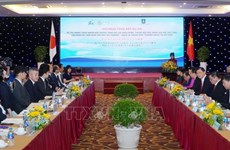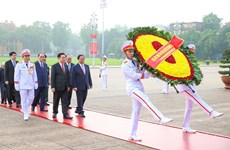Experts denounce China’s illegal acts in East Sea
The Vietnamese media can and should effectively expose China's
territorial claims in the East Sea and its placement of an oil rig in
Vietnamese waters as blatantly illegal acts, a senior official said on
June 21.
The Vietnamese media can and should effectively expose China's
territorial claims in the East Sea and its placement of an oil rig in
Vietnamese waters as blatantly illegal acts, a senior official said on
June 21.
They should do so by clearly informing the world that there is plenty of historical and legal evidence of the nation's sovereignty over the Hoang Sa (Paracel) and Truong Sa (Spratly) archipelagoes, said Dr. Tran Cong Truc, former Chairman of the National Boundaries Committee.
Speaking to Vietnam News on the sidelines of a roundtable conference held in the central city of Da Nang on China's illegal placement of oil rig Haiyang Shiyou-981 inside Vietnam's continental shelf and exclusive economic zone since May, he said the media should also highlight the specific international laws that China is violating.
"Vietnam's media and communications services should voice to the world the historical and legal evidence of the country's sovereignty over Hoang Sa (Paracel) and Truong Sa (Spratly), and the exclusive economic zone and continental shelf in line with international law," he said.
He added that the world must know how China violates international law including the United Nations Charter, the 1982 United Nations Convention on the Law of the Sea and the ASEAN-China Declaration on the Conduct of Parties in the East Sea (DOC).
World opinion would be a powerful weapon in forcing China to withdraw the oil rig from Vietnam's continental shelf and exclusive economic zone, he said.
Dr. Gerhard Will of the German Institute for International and Security Affairs said the crisis in the East Sea was rooted in natural resources including gas, oil and fishing.
He said it was very important to recognise that the crisis in the East Sea involving China and other countries in the region was one involving economic interests. It was likely to be a long-standing conflict in the region needing "different courses" for resolution, he added.
Daniel Schaeffer, an expert with France's Asia Research Centre, warned that China would deploy more oil rigs and its submarine fleet to protect the rigs in the East Sea.
Chairing the roundtable on June 22, Dr. Nguyen Hung Son said China's illegal placement the oil rig Haiyang Shiyou-981 in Vietnamese waters, its deployment of a large fleet of armed vessels, military ships, coast guards vessels and aircraft gave the lie to its professed "good neighbour and friendship" policy.
"China's armed vessels aggressively and consistently fired high-power water cannons at and intentionally rammed Vietnamese public service and civil ships. China's aggression in Vietnamese seas has raised serious concern among neighbouring countries, the US, Japan and Australia," Son said.
On May 26, Chinese ship 11209 sank a Vietnamese fishing vessel while it was operating normally in its traditional fishing grounds near Vietnam's Hoang Sa (Paracel) Archipelago.
The Chinese ship even callously blocked all efforts to save the vessel by Vietnamese fishing trawlers in the area.
On June 21, international scholars and domestic historical researchers visited the exhibition titled "Hoang Sa and Truong Sa Archipelagos – an inseparable part of Vietnam" at the Da Nang Museum before inspecting the wreck of the sunken vessel and meeting with its owner and crew.
All the scholars then signed on a map of Vietnam that includes Hoang Sa and Truong Sa, affirming that the two archipelagoes belong to Vietnam as the country has exercised its sovereignty since the 17th century and has historical and legal evidence to back its claim.
The exhibition displayed several collections of artefacts and documents that attest to Vietnam's sovereignty over the Paracel and Spratly archipelagoes.
Tran Duc Anh Son, Deputy Director of the city's Institute for Socio-Economic Development, said: "As many as 100 maps have been published between 1826 and 1980, of which 10 clearly show that Hoang Sa (Paracel) and Truong Sa (Spratly) belong to Vietnam."
"Of this map collection, 70 indicate that the frontier of Southern China is Hainan island and 10 maps indicate that the Paracel Archipelago belongs to Vietnam," he said.
He said further evidence can be found in two Postal Atlas Maps of China books published by the Directorate General of Posts, Ministry of Transportation of the Republic of China in 1919 (consisting of 49 maps) and in 1933 (29 maps) and one Atlas of the Chinese Empire, published by the China Inland Mission in 1909 (23 maps).
None of the three books list the Paracels and Spratlys in the maps and index pages, he noted.
Furthermore, the Am Linh Pagoda, a place of worship for seamen dispatched to the Paracel Islands during the reign of Nguyen Dynasty, has been standing since the 17th century on Ly Son Island, just 30km offshore Quang Ngai province, he added.-VNA
They should do so by clearly informing the world that there is plenty of historical and legal evidence of the nation's sovereignty over the Hoang Sa (Paracel) and Truong Sa (Spratly) archipelagoes, said Dr. Tran Cong Truc, former Chairman of the National Boundaries Committee.
Speaking to Vietnam News on the sidelines of a roundtable conference held in the central city of Da Nang on China's illegal placement of oil rig Haiyang Shiyou-981 inside Vietnam's continental shelf and exclusive economic zone since May, he said the media should also highlight the specific international laws that China is violating.
"Vietnam's media and communications services should voice to the world the historical and legal evidence of the country's sovereignty over Hoang Sa (Paracel) and Truong Sa (Spratly), and the exclusive economic zone and continental shelf in line with international law," he said.
He added that the world must know how China violates international law including the United Nations Charter, the 1982 United Nations Convention on the Law of the Sea and the ASEAN-China Declaration on the Conduct of Parties in the East Sea (DOC).
World opinion would be a powerful weapon in forcing China to withdraw the oil rig from Vietnam's continental shelf and exclusive economic zone, he said.
Dr. Gerhard Will of the German Institute for International and Security Affairs said the crisis in the East Sea was rooted in natural resources including gas, oil and fishing.
He said it was very important to recognise that the crisis in the East Sea involving China and other countries in the region was one involving economic interests. It was likely to be a long-standing conflict in the region needing "different courses" for resolution, he added.
Daniel Schaeffer, an expert with France's Asia Research Centre, warned that China would deploy more oil rigs and its submarine fleet to protect the rigs in the East Sea.
Chairing the roundtable on June 22, Dr. Nguyen Hung Son said China's illegal placement the oil rig Haiyang Shiyou-981 in Vietnamese waters, its deployment of a large fleet of armed vessels, military ships, coast guards vessels and aircraft gave the lie to its professed "good neighbour and friendship" policy.
"China's armed vessels aggressively and consistently fired high-power water cannons at and intentionally rammed Vietnamese public service and civil ships. China's aggression in Vietnamese seas has raised serious concern among neighbouring countries, the US, Japan and Australia," Son said.
On May 26, Chinese ship 11209 sank a Vietnamese fishing vessel while it was operating normally in its traditional fishing grounds near Vietnam's Hoang Sa (Paracel) Archipelago.
The Chinese ship even callously blocked all efforts to save the vessel by Vietnamese fishing trawlers in the area.
On June 21, international scholars and domestic historical researchers visited the exhibition titled "Hoang Sa and Truong Sa Archipelagos – an inseparable part of Vietnam" at the Da Nang Museum before inspecting the wreck of the sunken vessel and meeting with its owner and crew.
All the scholars then signed on a map of Vietnam that includes Hoang Sa and Truong Sa, affirming that the two archipelagoes belong to Vietnam as the country has exercised its sovereignty since the 17th century and has historical and legal evidence to back its claim.
The exhibition displayed several collections of artefacts and documents that attest to Vietnam's sovereignty over the Paracel and Spratly archipelagoes.
Tran Duc Anh Son, Deputy Director of the city's Institute for Socio-Economic Development, said: "As many as 100 maps have been published between 1826 and 1980, of which 10 clearly show that Hoang Sa (Paracel) and Truong Sa (Spratly) belong to Vietnam."
"Of this map collection, 70 indicate that the frontier of Southern China is Hainan island and 10 maps indicate that the Paracel Archipelago belongs to Vietnam," he said.
He said further evidence can be found in two Postal Atlas Maps of China books published by the Directorate General of Posts, Ministry of Transportation of the Republic of China in 1919 (consisting of 49 maps) and in 1933 (29 maps) and one Atlas of the Chinese Empire, published by the China Inland Mission in 1909 (23 maps).
None of the three books list the Paracels and Spratlys in the maps and index pages, he noted.
Furthermore, the Am Linh Pagoda, a place of worship for seamen dispatched to the Paracel Islands during the reign of Nguyen Dynasty, has been standing since the 17th century on Ly Son Island, just 30km offshore Quang Ngai province, he added.-VNA













